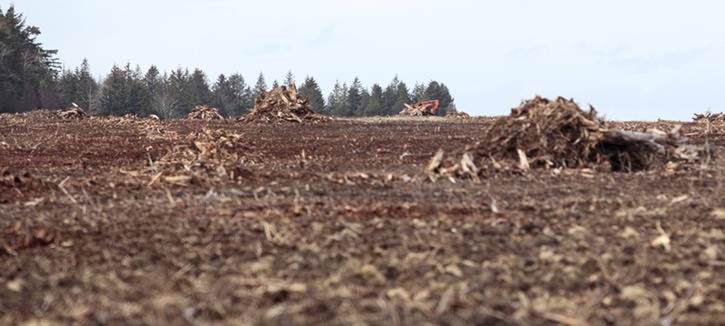Nowhere to hide, deer.
That is the message the Village of Masset hopes to send by turning most of the Masset Airport grounds into a close-cropped hayfield.
Last week, Masset council voted to seek a contract with local farmer Roger Stoltzfus, who answered a call for farming proposals by offering to seed the 120 acres with grass for making hay.
Stoltzfus would actually grow short, mowed grass in a buffer zone around the runway, and a taller mix of alfalfa, clover, timothy. and orchard grass that starts 100 to 200 feet away.
The taller grass would be cut twice a year and made into hay bales.
“I think this is a really neat idea for the village,” said Mayor Andrew Merilees, speaking at the April 24 council meeting.
“It could be a win, win, win.”
In 2003 and again in 2010, a deer bounded out from the brush that used to surround the Masset runway and got clipped by a plane’s propellor.
Rather than risk another deer strike, the village improved the airport fencing and recently had the whole 120 acres cleared of any brush.
“You can stand there and see fence to fence now, so they’ve got no place to hide,” said Trevor Jarvis, chief administrative officer for the village.
But the clearing cost $300,000, so it is not something the village can continue to do.
As Merilees pointed out, hay also tends to be quite pricey on Haida Gwaii because very little is grown on island, so it could be a win for local farmers, also.
Kal Manna, manager of the Masset Airport, said many rural airports lower their grounds maintenance by inviting some kind of farming. Airports in Bella Coola, Quesnel, and Abbotsford all have such contracts.
Manna sought advice from Transport Canada about the buffer zone and other safety measures, such as training, scheduling, beacons, and radios for everyone who plants and harvests the hay.
Manna did a hazard assessment for Stoltzfus’ proposal, and for another proposal by Trevor Brasier to grow a single acre of blueberries — an offer council declined in favour of negotiating a single contract.
Besides the danger to workers, the hayfield will likely attract more birds that could collide with planes.
But Manna said geese are already a common sight at the airport, and the buffer zone and other passive techniques can keep birds from harm’s way. Crews already resort to shooting loud ‘bear bangers’ to scare geese off the grounds from time to time.
Islander Pat Johnston wrote councillors a letter opposing the idea in favour of letting natural vegetation regrow and be regularly maintained.
“There is already a strain on the birds in Delkatla Sanctuary with the airport being so close,” he wrote, adding that he hopes the village does not install warning cannons to keep birds off.
“The fences barely keep the deer out now; once there is ‘food’ inside they will be more determined.”
Manna said many details remain, but the village should be able to handle the concerns Johnston raised, including a question about contaminated soil.
Soil samples tested by Stoltzfus show the land is good for forage crops, he said, adding that fuel or oil leaks are highly unlikely at an airport, where safety standards are high.
“Honestly, it’s probably way cleaner than the side of the highway,” he said.
